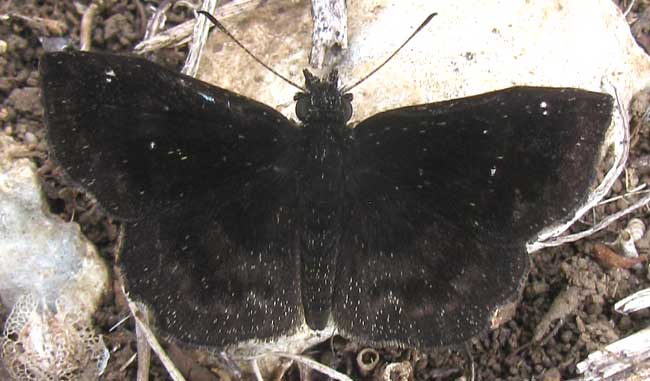Excerpts from Jim Conrad's
Naturalist Newsletter

from the February 28, 2010 Newsletter issued from Hacienda Chichen Resort beside Chichén Itzá Ruins, central Yucatán, MÉXICO; limestone bedrock, elevation ~39m (~128ft), ~N20.676°, ~W88.569°
A SPREADWING SKIPPER
Along a sunny trail at the forest's edge a small, black butterfly landed on a white limestone rock, seen above. It struck me as unusual because not many almost-pure black butterflies are seen. Also, it had a thick, big-headed body and densely hairy wings like many skippers have, yet most skippers I run across hold their wings at 45° angles, or at two diagonal angles, not horizontally as this one did.
The next day Bea in Ontario came back with a verdict: The closest picture she could find on the Web matching it was of the Mazans Scallopwing, Staphylus mazans, a "Spreadwing Skipper" of the Skipper Family, the Hesperiidae. That big family embraces about 788 Mexican species, and our skipper's subfamily, the Pyrginae, includes about 212 Mexican species, so there may be lots of look-alike relatives.
Mazans Scallopwing, however, is documented only from the US border region with Mexico, south to about Veracruz, so if we have them in the Yucatán ours must represent an "island" or disjunct population. Also, my skipper seemed blacker than that species.
Bea with her own doubts wrote to Paul Opler, who oversees the wonderful Butterflies and Moths of North America website at http://www.butterfliesandmoths.org.
Paul quickly replied that he just couldn't say what it was. He explained:
In Mexico, there more species of Staphylus than in the U.S., as well as other genera that are closely related. I do not know these well enough to render an opinion. An expert such as Andy Warren might wish to dissect the individual, not possible with an image.
So, there: Basically we pushed the ID process as far as an amateur can without sacrificing a butterfly to dissection, and even with a decent photo all we can say is that probably it's in the Subfamily Pyrginae, which embraces some 212 Mexican species. It's a good lesson though, reminding us that, especially in Mexico where species diversity is greater than in the North, and where much fewer studies have been made, sometimes you just can't come up with a final answer.
Caterpillars of Mazans Scallopwing, which our skipper must be closely related to if it's not the same thing, feed on members of the Goosefoot Family, the Chenopodiaceae, which Spinach also belongs to, and the Amaranth Family. Just last week I told you about our common Yellow Joyweed, which was a member of the Amaranth Family, so this is a good place for scallopwings.